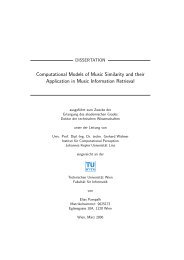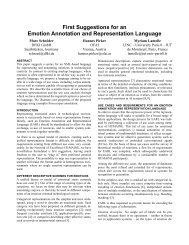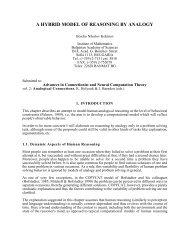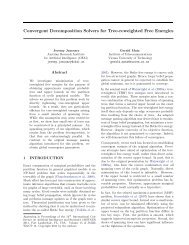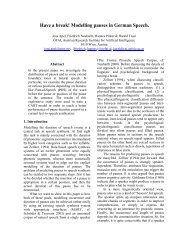Global Musical Tempo Transformations using Case Based ... - OFAI
Global Musical Tempo Transformations using Case Based ... - OFAI
Global Musical Tempo Transformations using Case Based ... - OFAI
You also want an ePaper? Increase the reach of your titles
YUMPU automatically turns print PDFs into web optimized ePapers that Google loves.
Another issue is assuring the consistency of the case base. A case base<br />
inconsistency occurs when the case base contains two cases with the same<br />
problem description, but contradictory solutions. Obviously, different solutions<br />
may not always be contradictory, since in many domains (e.g. expressive<br />
music performance) there may be multiple valid solutions. But for analytical<br />
CBR tasks such as classification, assigning contradictory labels to the same<br />
problem is a realistic possibility. Assuming the correctness of the solution in<br />
both cases, an inconsistency may indicate an incorrect problem description<br />
(ca<strong>using</strong> different problems to be represented in identical ways).<br />
In a special issue of Computational Intelligence on maintaining case based<br />
reasoning systems [28], Wilson and Leake [124] propose a general framework<br />
for maintenance of CBR systems. To categorize maintenance policies, they<br />
divide the maintenance process into three phases: 1) data collection, 2) triggering,<br />
and 3) execution. During data collection, the maintainer gathers<br />
information about the state and performance. This information is used in a<br />
triggering phase to decide whether an actual maintenance operation should<br />
be carried out, and selects an appropriate operation from a set of possible<br />
operator types. In the execution phase, this operation is interpreted to the<br />
actual situation of the CBR system, to describe when and how the operation<br />
should be executed. The choices that are made in the general process of<br />
maintenance depend on the goals and constraints of the CBR system that<br />
is being maintained, such as problem solving efficiency goals, solution quality<br />
goals, size limits of the case base, or the expected distribution of future<br />
problems. Different combinations of goals and constraints lead to different<br />
maintenance policies. It should be noted that the maintenance does not apply<br />
solely to the case base itself, it may also operate on other knowledge<br />
containers, such as retrieval and reuse components of the CBR system.<br />
3.4 KI-CBR<br />
As mentioned in the beginning of this chapter, the spectrum of Instance<br />
<strong>Based</strong> Learning techniques contains rather simple techniques like Nearest-<br />
Neighbor Learning at one end of the spectrum. At the other end, we find<br />
the types of CBR that make thorough use of knowledge about the problem<br />
domain, the so-called Knowledge-Intensive CBR (KI-CBR). In this section<br />
we will focus on this kind of CBR.<br />
In real-world problems (like medical diagnosis, investment planning, and<br />
geological planning, but also expressive music transformation), approaches<br />
to problem solving that select and adapt cases only <strong>using</strong> syntactical criteria<br />
are often not adequate. Rather, a semantical approach may be needed. In<br />
42




